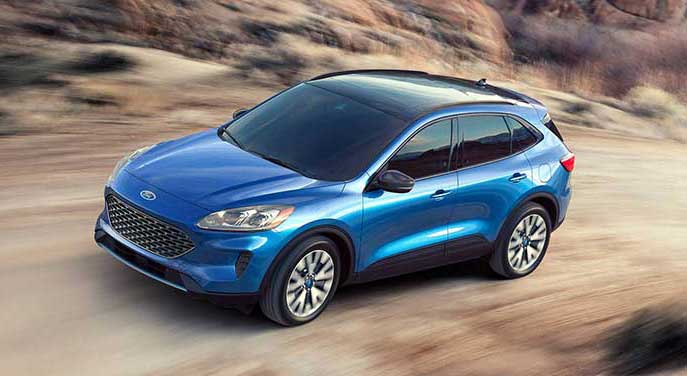
Charge time is 10 to 11 hours if you plug into a conventional household outlet and around 3.5 hours if you have access to a 240-volt source. Apparently, Ford intends the Escape PHEV to be used around town
 Ford may be out of the passenger sedan business but they’ve jumped into the hybrid/electric car market with both feet. The company has at least seven electrified models – mostly pickups and SUVs, but including the all-electric Mustang Mach-E, which doesn’t look like a Mustang at all.
Ford may be out of the passenger sedan business but they’ve jumped into the hybrid/electric car market with both feet. The company has at least seven electrified models – mostly pickups and SUVs, but including the all-electric Mustang Mach-E, which doesn’t look like a Mustang at all.
Right in the thick of it is the Escape, offered in 10 variations, including the plug-in hybrid (PHEV), which comes in three trim levels. Not to be confused with the non-plug-in Escape Hybrid, the 2022 Escape Plug-in Hybrid isn’t available with all-wheel drive and has a slightly more powerful engine than its stablemate.
Power for the PHEV is delivered via a normally-aspirated 2.5-litre four-cylinder engine fed by a lithium battery pack and features the Atkinson valvetrain setup. Basically, this electronically retards the camshaft slightly to leave the valves open a little longer and prolong the combustion process for maximum efficiency. The downside is a slight loss of power compared to a conventional engine, but it wrings as much fuel economy as possible out of the engine.
Transmission is continuously variable and a 96-kilowatt electric motor is mated to the two. The result is a combined fuel economy of 2.2 litres/100 km, which is comparable to the Toyota Prius. That goes up to 5.8 litres if you run on gasoline power only, but the Escape PHEV seems to stay on purely electric power longer than some other vehicles of this type.
Charge time is 10 to 11 hours if you plug into a conventional 110-volt household outlet and around 3.5 hours if you have access to a 240-volt power source. Apparently, Ford intends the Escape PHEV to be used around town, for short runs on 100 per cent electric power, and then plugged in overnight to be ready for the next day.
By my reckoning, you can run 30 to 40 km on pure electric power before it runs out – if you have a light foot. The transition from electric to internal combustion is absolutely seamless – most of the time I didn’t even know what mode I was in unless I checked.
This vehicle has 1,852 litres (65.4 cubic feet) of cargo space with the back seat folded down and will seat five adults in reasonable comfort. The seats don’t fold down completely flat, but access from the back is straightforward. The Toyota RAV4 Hybrid is good for 1,977 litres, so the Escape is a bit less spacious.
The PHEV has a significantly smaller towing capacity than the regular Escape: 680 kg versus 1,587 kg. No doubt Ford doesn’t want any undue strain put on the drivetrain.
One thing Ford has managed to build into this Escape is a nice sense of driveability. Switchgear and controls are easy to figure out and use, and Ford seems to be less interested in impressing drivers with its grasp of glitzy technology than some other manufacturers. It does have a heads-up display for speed and so on, and it’s pretty useful. It also has a readout that lets you know the charge level of the battery pack.
I also loved the seats. Compared to its luxury stablemate Lincoln and Ford, this is a comfortable car to spend time in. Ford has managed to make the Escape PHEV comfy without overdoing it.
The Escape is also one of those models that benefit from being around for a while. Now in its 22nd year, it was originally co-designed by Mazda and it shows. It’s definitely mainstream and aimed at drivers who care less about ostentation and luxury and more about practicality – not to mention excellent fuel economy.

Switchgear and controls are easy to use, and Ford seems to be less interested in impressing drivers with glitzy technology than some other manufacturers
2022 Escape Plug-in Hybrid
Power: 2.5-litre four-cylinder engine and 96-kilowatt electric motor
Transmission: continuously variable
Drive: front-wheel
Horsepower: 221 at 6,250 rpm
Torque: 155 foot pounds at 4,500 rpm
Base price: $38,449
Fuel economy (litres/100 km): 2.2 hybrid and 5.8 gas only, with regular gas
Alternatives: Toyota RAV4, Volvo XC90, Hyundai Santa Fe, Kia Niro, Mitsubishi Outlander, Subaru Crosstrek, Mini Cooper Countryman.
Ted Laturnus has been an automotive journalist since 1976. He was named Canadian Automobile Journalist of the Year twice and is past president of the Automobile Journalists Association of Canada (AJAC). For interview requests, click here.
The opinions expressed by our columnists and contributors are theirs alone and do not inherently or expressly reflect the views of our publication.
© Troy Media
Troy Media is an editorial content provider to media outlets and its own hosted community news outlets across Canada.

